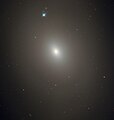Plik:Messier85 - HST - Potw1905a.jpg

Rozmiar podglądu – 567 × 599 pikseli. Inne rozdzielczości: 227 × 240 pikseli | 454 × 480 pikseli | 727 × 768 pikseli | 969 × 1024 pikseli | 1938 × 2048 pikseli | 3860 × 4079 pikseli.
Rozmiar pierwotny (3860 × 4079 pikseli, rozmiar pliku: 2,97 MB, typ MIME: image/jpeg)
Historia pliku
Kliknij na datę/czas, aby zobaczyć, jak plik wyglądał w tym czasie.
| Data i czas | Miniatura | Wymiary | Użytkownik | Opis | |
|---|---|---|---|---|---|
| aktualny | 10:45, 4 lut 2019 |  | 3860 × 4079 (2,97 MB) | Fabian RRRR | == {{int:filedesc}} == {{Information |Description='''The darkness within? This atmospheric image shows a galaxy named Messier 85, captured in all its delicate, hazy glory by the NASA/ESA Hubble Space Telescope. Messier 85 slants through the constellation of Coma Berenices (Berenice’s Hair), and lies around 50 million light-years from Earth. It was first discovered by Charles Messier’s colleague Pierre Méchain in 1781, and is included in the Messier catalogue of celestial objects. Messier 8... |
Lokalne wykorzystanie pliku
Poniższa strona korzysta z tego pliku:
Globalne wykorzystanie pliku
Ten plik jest wykorzystywany także w innych projektach wiki:
- Wykorzystanie na ar.wikipedia.org
- Wykorzystanie na de.wikipedia.org
- Wykorzystanie na en.wikipedia.org
- Wykorzystanie na fr.wikipedia.org
- Wykorzystanie na hu.wikipedia.org
- Wykorzystanie na it.wikipedia.org
- Wykorzystanie na ja.wikipedia.org
- Wykorzystanie na lt.wikipedia.org
- Wykorzystanie na mk.wikipedia.org
- Wykorzystanie na ru.wikipedia.org
- Wykorzystanie na sv.wikipedia.org


